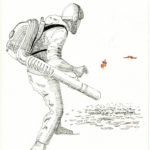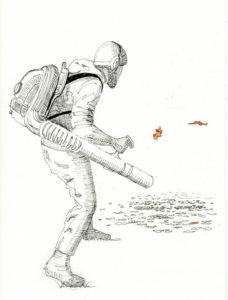
By Ian L. Todreas
Each spring and fall, dozens of landscaping companies dispatch teams to yards throughout Belmont to cut, trim, mow, rake, and blow hedges, bushes, lawns, and beds into coffee-table-magazine standard perfection. But at what cost? These services are not inexpensive. Moreover, their hidden costs are significant.
Gasoline-powered lawn equipment, such as leaf blowers, lawnmowers, weed whackers, and hedge trimmers, are notorious for emitting proportionally vast amounts of pollution—and making a heck of a lot of noise. Leaf blowers, in particular, deserve a close look. Unlike many other gasoline-powered lawn tools, for the amount of time they are used and the labor they save, they are especially bad for local air quality, plantings, human health, and any unprotected ears.
Air quality impacts of leaf blowers
The engines of gas-powered blowers come in two varieties: two-stroke and four-stroke. Two-stroke engines are in lighter, cheaper blowers. By design, the engines mix fuel with oil, and roughly 30 percent of fuel doesn’t fully combust. This means that the engines emit large amounts of air pollutants—carbon monoxide, nitrous oxides and hydrocarbons—all toxic to human health. Four-stroke engines are larger, heavier, and more powerful. While they emit less air pollution per unit of fuel, they are still quite polluting.
Almost all these engines operate without air quality controls or filters. Studies have measured a two-stroke leaf blower emitting 299 times the amount of hydrocarbons (HCs) of a pickup truck and 93 times those of a sedan. Using one for 30 minutes generates the same amount of HCs as driving a pickup 3,900 miles.
The age and model of leaf blowers matter, but only a little. Ultrafine particle levels in the air near an 11-year-old leaf blower were 50 times higher than at a nearby clogged intersection at rush hour. With a current-model leaf blower, in the same round of tests, the ultrafine particle level was still more than 40 times higher than at the busy intersection. The best-selling commercial leaf blower, according to a California Air Resources Board fact sheet, when operated for one hour, emits smog-forming pollution comparable to driving a Toyota Camry for 1,100 miles, or approximately the distance from Los Angeles to Denver.
In addition to spewing large amounts of toxic, carcinogenic pollutants into our yards, leaf blowers introduce other air-quality problems. The hurricane-force winds they generate to push leaves around also launch all kinds of fine and coarse irritants into the air, not only dirt and dust (including fine particles from other sources that have already settled on the ground), but also pollen, mold, animal feces, heavy metals, and chemicals from herbicides and pesticides. These particles can remain aloft for hours before resettling, posing problems for seniors, children and anyone nearby with compromised lungs.
Noise pollution and health of operators
The high-pitched whine of a leaf blower is presumably the origin of the nickname, “the Devil’s hairdryer.” This insidious feature is the result of housing the machine’s internal fan without insulation, making the leaf blower more irritating than an electric motor of equivalent loudness.
I don’t need a study to tell me that leaf blowers are loud (too loud!). But it is helpful to know exactly how leaf blowers compare to other noisemakers in our midst. Noise is measured in units of decibels (dB). A refrigerator operates at 50 decibels, whereas a table saw operates at 105 decibels. Decibels are not a linear scale; each increase of 10, say from 60 to 70, represents a noise 10 times more powerful. From 50 feet away, most leaf blowers measure in the 70-75 dB range—about the same noise you’d expect 50 feet from a freeway. (Most instrument- measured sound levels are now adjusted to reflect the ear’s response to different frequencies, known as A-weighting or dBA. Belmont by-law §60-615 states exterior noise standards as dBA.)
For the unfortunate souls operating the blowers, the noise is up to 95 dB, almost as loud as standing next to a motorcycle, according to the CDC. (Hopefully the operators are provided industrial strength ear protection, and wear it.) As for the rest of us, my observation is that most homes and schools in Belmont are within 50 feet of properties that could be subject to a leaf blower.
And in practice, the term “leaf blower” is almost a misnomer, since contractors employ them most of the year instead of hand tools, to clear lawns, walkways, flower beds, stonework and streets. It’s common to see a landscape crew of three or four blow mixed debris into the public street, then move it again into a pile to be carted away. The town of Arlington acknowledged year-round use in its discussions of a seasonal leaf blower ban.
From 50 feet away, most leaf blowers measure in the 70-75dB range—about the same noise you’d expect 50 feet from a freeway.
Other concerns
Leaf blowers damage more than air quality and suburban tranquility. The force of their wind damages grasses, flowers, and shrubbery with shallow root systems. Oil spills from refueling and maintenance cause soil and groundwater pollution. Burning those fossil fuels is a local contribution to global climate change. The social justice implications of asking those less fortunate with fewer employment choices to inhale the fumes and endure the deafening noise are profoundly disturbing, just to move leaves around that, up until the 1970s, were either left in place to decompose or handled with a simple rake.
What can we do?
Leaf blowers are probably not going away anytime soon. But we shouldn’t have to live with their toxic outputs and ear-splitting whining. So what can we do to preserve the tranquility of our neighborhoods and the quality of the air we breathe? Plenty.
Regulatory solutions
Town government is empowered to enact bylaws that limit excess noise (noise ordinances), and Belmont has some on the books. Belmont could also pass a ban on leaf blower use. Some communities have done one or both, but these efforts are rarely successful in limiting leaf blower use. This is partly because regulations and bylaws like these are not enforced; towns tend to tread lightly on enforcing regulations that don’t have overwhelming public support or appear to be infringing on life, liberty, and perceptions of the pursuit of individual happiness. No law enforcement agency ever enforces the regulation against vehicle idling, for example, when a private citizen sits idling in their car.
Voluntary measures
An alternative to regulatory solutions is to adopt a voluntary campaign to limit leaf blowers. Belmont has a good track record of success with voluntary programs, including Better Homes Belmont, Belmont Goes Solar, and Belmont Drives Electric. Some elements of that campaign could include:
Setting up a public pledge for homeowners to sign not to use leaf blowers, not to hire companies that use leaf blowers, and to only hire companies that use rakes.
Having the town set an example by retiring its leaf blowers and using alternatives.
Establishing and promoting a preferred vendor list of quiet landscapers, and/or setting up a recognition component to bring positive publicity to landscapers who forgo leaf blowers.
Setting up an educational campaign to raise awareness about leaf blowers and their hidden costs so homeowners are aware of the impacts of their choices.
Educating and incentivizing residents and landscapers to replace gas-powered leaf blowers with quieter models, such as electric battery-powered leaf blowers. The quieter models produce 65 dB at the source, not 85.
Lastly, Belmont as a town, or interested precincts or neighborhoods, could embark on becoming an American Green Zone Alliance-certified property or area. According to Quiet Communities, a nonprofit that runs this certification program, “an AGZA Green Zone is a defined area of land—a park, a campus, a shopping center, a neighborhood—maintained routinely without the use of gas-powered equipment, relying instead on a combination of advanced battery-powered equipment, sustainable landscaping, and manual methods.” There is no reason to continue to endure the mental and physical harm from leaf blowers.
Ian Todreas is an environmental consultant who has advised federal, state, and local agencies on mobile source emissions and climate issues for more than 20 years. He is a Belmont resident, Town Meeting member, former co-chair of the Belmont Energy Committee, and artist at updoggallery.com.



Sorry, the comment form is closed at this time.